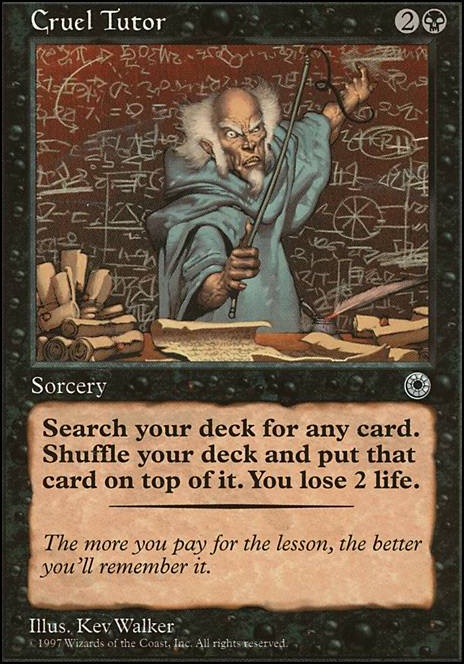Land (29)
- 1x Bayou
- 1x Bloodstained Mire
-
1x
Botanical Sanctum

-
1x
Breeding Pool

- 1x City of Brass
-
1x
Command Tower

- 1x Exotic Orchard
- 1x Flooded Strand
- 1x Forbidden Orchard
- 1x Gaea's Cradle
- 1x Gemstone Caverns
-
1x
Mana Confluence

-
1x
Marsh Flats

- 1x Misty Rainforest
- 1x Morphic Pool
- 1x Nurturing Peatland
-
1x
Overgrown Tomb

-
1x
Polluted Delta

-
1x
Scalding Tarn

-
1x
Tarnished Citadel

- 1x Tropical Island
-
1x
Underground River

- 1x Underground Sea
- 1x Verdant Catacombs
- 1x Waterlogged Grove
-
1x
Watery Grave

- 1x Windswept Heath
-
1x
Wooded Foothills

-
1x
Yavimaya Coast

Enchantment (8)
Instant (23)
-
1x
Abrupt Decay

- 1x Assassin's Trophy
- 1x Brainstorm
- 1x Chain of Vapor
- 1x Demonic Consultation
-
1x
Entomb

-
1x
Flusterstorm

- 1x Force of Negation
- 1x Force of Vigor
- 1x Force of Will
- 1x Lim-Dul's Vault
-
1x
Memory's Journey

-
1x
Mental Misstep

- 1x Mystical Tutor
- 1x Narset's Reversal
-
1x
Nature's Claim

- 1x Noxious Revival
-
1x
Pact of Negation

-
1x
Swan Song

- 1x Tainted Pact
- 1x Vampiric Tutor
- 1x Veil of Summer
- 1x Worldly Tutor
Sorcery (14)
Commander (1)
Creature (19)
-
1x
Arbor Elf

-
1x
Birds of Paradise

-
1x
Elves of Deep Shadow

-
1x
Elvish Mystic

-
1x
Eternal Scourge

-
1x
Fatestitcher

- 1x Fyndhorn Elves
- 1x Ghostly Pilferer
- 1x Gilded Drake
- 1x Hermit Druid
-
1x
Jin-Gitaxias, Core Augur

-
1x
Llanowar Elves

- 1x Misthollow Griffin
-
1x
Narcomoeba

-
1x
Oakhame Adversary

-
1x
Razaketh, the Foulblooded

- 1x Spellseeker
- 1x Thassa's Oracle
- 1x Vilis, Broker of Blood
Artifact (6)
Suggestions
Updates Add
Comments View Archive
Attention! Complete Comment Tutorial! This annoying message will go away once you do!
Important! Formatting tips — Comment Tutorial — markdown syntax
Please login to comment
| Top Ranked |
|
| Date added | 9 years |
| Last updated | 5 years |
| Exclude colors | WR |
| Legality | This deck is not Commander / EDH legal. |
| Rarity (main - side) | 10 - 0 Mythic Rares 61 - 0 Rares 17 - 0 Uncommons 12 - 0 Commons |
| Cards | 100 |
| Avg. CMC | 2.11 |
| Tokens | Bird 2/2 U, Spirit 1/1 C, Zombie 2/2 B |
| Folders | Interesting concepts, EDH Inspiration, cEDH, inspiration, EDH, cutthroat canon, Inspiration, future decks, Willing, Unoriginal Deck Lists |
| Votes | |
| Ignored suggestions | |
| Shared with | |
| Views |


